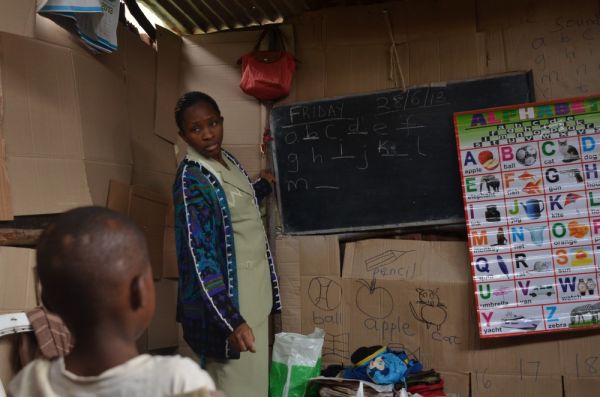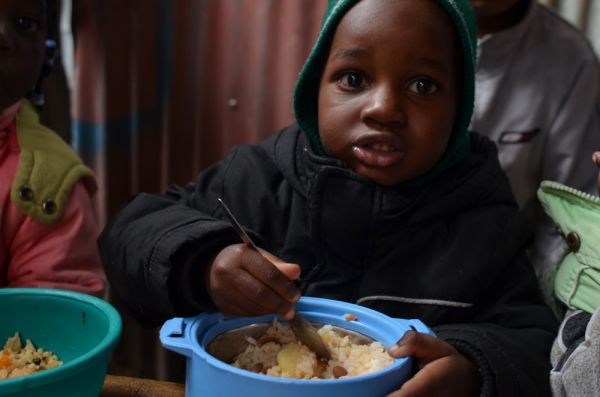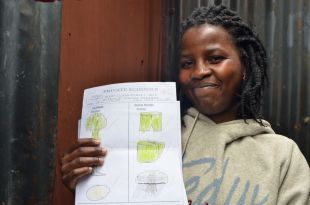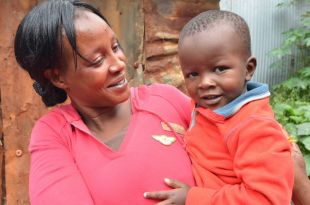No Recess for Informal Schools During Kenyan Teachers’ Strike

Ms. Nyongesa teaches students the alphabet at an informal school she founded.
For the past week, a nationwide teachers’ strike over low pay and benefits has shut down Kenya’s public schools, so the streets of Nairobi’s Mathare slum have been filled with playing children.
But three-year-old James hasn’t missed a day of class. Every morning, while other children kick soccer balls outside, he and his seven classmates sit on worn wooden benches in a tiny shack made of cardboard and corrugated iron, reciting the alphabet and counting to ten as their teacher writes on a secondhand chalkboard.
James doesn’t attend a private school – his single mother can’t afford that – but instead learns in an informal kindergarten run by a local mother named Emily Nyongesa. Ms. Nyongesa, 31, opened her school to provide a low-cost education option for parents in the slum who can’t afford formal schooling for their children. Unlike the children in most Kenyan schools, Ms. Nyongesa’s students don’t wear uniforms and have scant supplies, but they study the same curriculum as is taught in formal schools, seven hours a day, five days a week. In a country where only 52 percent of children attend pre-primary school, Ms. Nyongesa’s little classroom presents a grassroots solution to a nationwide education crisis, and is another example of how Nairobi residents fend for themselves when government services are inadequate or too expensive.

James chows down on his lunch.
The school day begins like any other. James’s mother Winfred drops him off at 8 a.m. with a plastic tub containing his snacks and lunch. He places his tiny backpack in a pile on the mud-and-carpet floor before taking his seat. Once all the children are assembled, Ms. Nyongesa leads a short prayer—Kenya is a deeply religious country—before launching into the days’ lesson.
“Yesterday was Thursday,” she tells the class. “So today is…”
“Tuesday?” ventures one child. Ms. Nyongesa shakes her head. When another student offers the correct answer, Ms. Nyongesa enthusiastically congratulates her and leads the children in a song to help them remember the days of the week. Then they move on to a lesson on the alphabet.
Most parents send their children to Ms. Nyongesa’s improvised school because they can’t afford anything else. Though primary public education is free in Kenya, parents must still pay for uniforms, lunches, supplies and activity fees, plus arbitrary costs imposed by underpaid teachers such as “exam fees.” All told, public school fees could run up to eight hundred shillings ($9.40) a month or more.

Winfred shows off James’s work. She likes Ms. Nyongesa’s school because it’s cheaper than formal schools.
That’s too much for Winfred, who earns just two or three hundred shillings a day washing clothes, so she opted for Ms. Nyongesa’s lower rate of 400 shillings ($4.70) a month. “This school is good because it’s cheaper,” she said. “Government is too much money.”
Other parents choose Ms. Nyongesa’s school because it is close to home, or because they can pay in installments over the month. One man sends his six-year-old niece there because he thought she wasn’t yet ready for first grade, and hoped Ms. Nyongesa would get her up to speed.
Soft-spoken and wearing a plain dress and cardigan, Ms. Nyongesa is not a trained teacher. But she said she loves working with children so she decided to open the school to supplement her husband’s income. Her pay is meager, just 1,700 shillings a month (about $20 USD) after she pays the rent of 1,500 ($17.60) shillings for the classroom, but hopes that she’ll be able to attract more students to boost her pay.
She teaches with few supplies, wiping the blackboard with a chunk torn from a foam mattress. Without a photocopier, she has to write letters and numbers by hand in the top of each students’ notebook for them to copy below. And with students ranging from three to six years old, some of the younger children are left with nothing to do while Ms. Nyongesa teaches advanced concepts to the older ones.

Agnes Wangoi and her son, Joshua, who attends Ms. Nyongesa’s school.
Still, one parent said she prefers this situation to a public school, where class sizes can be as high as sixty pupils.
Despite her meager supplies, Ms. Nyongesa runs her school like a professional. When a student shows up an hour late, she demands a note explaining her tardiness, and the students are regularly tested with exams. Winfred showed off a stack of her son’s quizzes, all with passing grades.
“He can read numbers,” she said proudly. “He knows ‘ABCD’.”
After the morning’s lessons, the students have a snack before they sing songs. Then it’s gym class, which means jumping-jacks and running in a nearby field (though on the day I visited it was too muddy to go outside) before lunchtime and a nap.
During holidays Ms. Nyongesa studies early-childhood development, but once she earns her degree, she has no plans to work at a government school. Instead, she’d like to increase enrollment at her own school, and upgrade to a concrete floor with more permanent walls so that more Mathare children can learn there.
“God willing,” she said, “it will grow.”
Photos by Jason Patinkin









